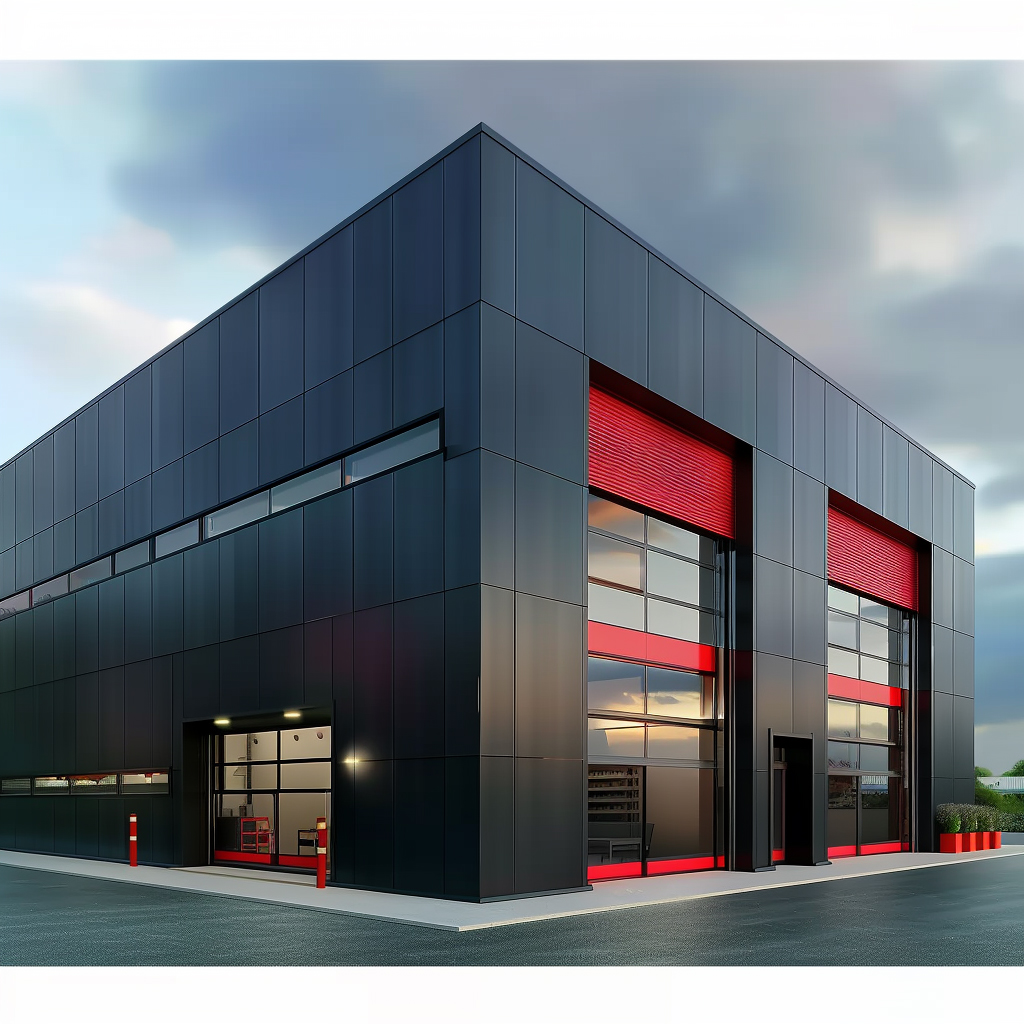Steel Structures: The Backbone Of Modern Architecture

Steel Structures: The Backbone Of Modern Architecture
When you gaze upon the skylines of modern cities, those soaring towers and innovative shapes reaching for the heavens, you're looking at the marvels of steel structures. But what exactly is a steel structure? Let's delve into the anatomy, benefits, and applications of these engineering feats that have become the skeletons of contemporary construction.
The Anatomy of a Steel Structure
At its core, a steel structure is a framework made up of steel components connected together to carry loads and provide full rigidity. The strength-to-weight ratio of steel is significantly high which makes it an ideal choice for constructing buildings that need to be both strong and light.
Steel structures are comprised of beams, columns, trusses, and other components that work together to support loads. The making of these structures involves precision and planning—each piece is engineered to meet specific design criteria, bolstering the overall integrity of the finished product.
The Benefits of Choosing Steel
Why do architects and engineers gravitate towards steel for their projects? Here are some compelling reasons:
Durability: Steel is highly durable and can withstand severe weather conditions, fires, and earthquakes when properly designed.
Adaptability: Steel structures can be easily modified, making them adaptable to changing needs. Additions and changes can be facilitated without impacting the overall strength of the structure.
Sustainability: Steel is 100% recyclable, and the industry has made strides in reducing emissions and energy usage in its production.
Cost-Effectiveness: Although the initial cost may be higher, long-term maintenance of steel is relatively low. Plus, the longevity of steel structures is far superior, providing better value over time.
Speed of Construction: Steel parts can be pre-fabricated and assembled on-site, significantly cutting down construction time.
Applications Across the Board
Steel structures aren't confined to giant skyscrapers or wide-spanning bridges. They're also found in residential buildings, industrial complexes, stadiums, schools, hospitals, and almost any structure we use in daily life. Their versatility and capability to span large distances without intermediate support make them an architect's ally in bringing their most audacious visions to life.
The Future of Steel Structures
With the push towards more sustainable construction practices, steel stands out for its potential in green building initiatives. New technologies are being researched, like smart steel, which can heal its own micro-cracks, further expanding the possibilities for this resilient material.
Innovation in protective coatings also means that steel can better resist corrosion, contributing to longer life spans and lower maintenance costs. With computer-aided design and manufacturing processes, steel structures will only get smarter, more efficient, and more integral to the stories we build into our world.
Conclusion: The Framework That Shapes Our World
Steel structures have reshaped our environment, propelling us into an age where almost anything seems possible. The blend of strength, flexibility, aesthetics, and sustainability makes steel an invaluable resource in construction. As we continue to innovate and push the boundaries, steel structures will undoubtedly continue to play a critical role in the evolution of our built landscape, creating legacies that stand the test of time.
Can you tell me about the advantages and characteristics of steel structures?
Certainly! Steel structures are favored in many construction projects for their unique characteristics and numerous advantages:
Advantages of Steel Structures:
Strength & Durability: Steel is one of the toughest construction materials, which leads to robust and long-lasting buildings. Its high tensile strength and resistance to deformation mean that steel structures require less material to achieve the same support as other building materials.
Design Flexibility: Steel's versatility allows for creative and innovative design. It can be molded into almost any shape, and its lightweight nature makes it suitable for large spans in building designs without the need for numerous support columns.
Speed of Construction: Steel components are often fabricated off-site and simply assembled on-site. This prefabrication means that construction time is considerably reduced compared to traditional concrete structures.
Sustainability: Steel is fully recyclable, and most steel structures are made from a significant percentage of recycled material. Moreover, steel does not emit toxic fumes during fires, contributing to environmental friendliness and occupant safety.
Economic Efficiency: While the upfront cost of steel may be higher, the life cycle cost is often lower due to lower maintenance needs and longer lifespan of structures.
Adaptability & Expansion: Steel structures can be easily modified in the future for new applications, additional loads, vertical expansions, and changes in owner's needs.
Characteristics of Steel Structures:
High Strength-to-Weight Ratio: Steel has a high strength-to-weight ratio, which means it provides high strength without adding significant weight.
Ductility: Steel can undergo significant deformation before failure, which is valuable in areas subject to high winds or seismic activity.
Conductivity: Steel is a good conductor of heat and electricity, which can be a disadvantage in terms of fire protection but can be managed with proper insulation and design techniques.
Homogeneity & Isotropy: Their properties do not change significantly with time or in different environmental conditions, making steel a predictable material when calculating load and lifespan.
Fatigue Strength: Steel structures can withstand repeated loading cycles without significant wear and tear.
These advantages and characteristics make steel a preferred choice not just for high-rise buildings and bridges but for a variety of applications including warehouses, residential homes, and commercial complexes. The success of steel in construction is due to its inherent qualities, which have been optimized and improved over time through innovation in metallurgy and design methods.
Can you explain the process of constructing a steel structure?
Constructing a steel structure involves a series of steps from design to erection, ensuring that the final structure meets all the specified requirements of strength, functionality, and safety. Here's a general overview of the process:
Conceptual Design: The process starts with architects and structural engineers working out the building's design criteria, shape, load-bearing capabilities, and aesthetic considerations, taking into account the intended use of the structure.
Detailed Engineering: Detailed structural engineering follows, where precise calculations are made to design the structural elements. Computer-aided design (CAD) software is often utilized to model the structure and optimize the use of materials.
Fabrication: Once the design is finalized and approved, fabrication of the steel elements takes place. This happens off-site in a controlled factory setting where steel is cut, shaped, drilled, and welded to form columns, beams, girders, and other components. Advanced machinery ensures adherence to precise specifications.
Quality Control: Throughout the fabrication process, rigorous quality control is enforced. This includes inspections, non-destructive testing, and ensuring that all components meet the necessary standards and tolerances.
Transportation: After the components are fabricated, they are transported to the construction site. Logistics planning is crucial to ensure that the right pieces arrive in the correct sequence to optimize the erection process.
Foundation Construction: While steel fabrication is going on, the construction site is prepared, and the foundation is laid. The type of foundation varies based on the load requirements and soil conditions but usually involves pouring concrete into excavated footings.
Erection: Erection is the process of assembling the fabricated steel members into the framework of the structure. Cranes are typically used to lift the components into place. Bolting and welding are the most common methods of securing components together.
Plumbing and Alignment: After the primary frame is erected, workers ensure the vertical and horizontal alignment is accurate, and the structure is correctly plumbed. Adjustments are made as necessary to maintain the integrity of the design.
Installing Secondary Components: This involves adding purlins, girts, and façade elements that provide lateral supports to the main frame and serve as attachment points for wall and roofing systems.
Cladding: The external skin of the building is added using various materials like metal sheeting, insulation layers, and sometimes additional concrete work. This step also includes the installation of windows, doors, and any other exterior features.
Finishing: Interior work follows, which can include the installation of HVAC systems, plumbing, electricity, elevators, and interior partitions. The interior finishing touches are also applied in this phase, such as painting, installing ceilings, and laying floors.
Inspections and Certifications: The structure undergoes inspections to ensure compliance with building codes and regulations. Any issues identified during inspection must be addressed before the structure can be certified for occupancy.
Handover: Upon completion and satisfactory inspection, the building is handed over to the owner for occupancy.
This process is a simplified glimpse into the construction of a steel structure and may vary depending on the project's complexity, location, and specific requirements. Coordination between various stakeholders, including engineers, architects, contractors, and inspectors, is vital throughout the construction process.
How does the cost of constructing a steel structure compare to other construction methods?
The cost of constructing a steel structure can vary significantly based on factors such as design complexity, location, and the current price of materials. However, when compared to other construction methods, steel structures offer several financial advantages and considerations:
Initial Cost vs. Long-Term Savings: The initial material cost of steel can be higher than traditional materials like concrete and wood. However, steel offers durability, strength, and requires less maintenance, which can lead to cost savings over the life of the building.
Speed of Construction: Steel structures can be pre-engineered and fabricated off-site, allowing for quicker assembly on-site. This can considerably reduce labor costs and the overall construction timeline, translating into direct cost savings for the project.
Design Flexibility: Steel's high strength-to-weight ratio offers greater design flexibility without significant additional costs. This can allow for larger open spaces and more ambitious architectural designs without drastically impacting the budget.
Sustainability: Steel is highly recyclable, which may not directly reduce the initial costs but can contribute to lower environmental impact fees and potential tax incentives tied to green building practices.
Lifecycle Costs: The durability and resistance of steel to environmental factors such as termites, moisture, and mold, reduce the lifecycle costs associated with maintenance, replacements, and repairs as compared to wood or concrete structures.
Insurance Costs: Due to steel's non-combustible nature, insurance costs for steel structures can be lower than for buildings constructed with more flammable materials.
In conclusion, while the upfront cost of steel can sometimes be higher, its advantages in speed of construction, flexibility, sustainability, and lower lifecycle costs often make it a cost-effective choice for a wide range of projects compared to traditional construction methods. It's always recommended to perform a detailed cost-benefit analysis for specific projects, taking into account the current prices of materials and other local factors.
Can you provide examples of projects where constructing a steel structure was more cost-effective?
Certainly! There have been numerous projects worldwide where steel structures have proven to be more cost-effective due to various factors, including speed of construction, reduced labor costs, and overall efficiency. Here are a few notable examples:
Sports Stadiums and Arenas: Many modern sports venues favor steel construction. The Beijing National Stadium, also known as the Bird's Nest, utilized a steel structure to create its iconic design. The stadium's construction was efficient and cost-effective due to prefabricated steel sections.
High-Rise Buildings: The Empire State Building in New York is an early example of steel's cost-effectiveness. Its construction only took 410 days, primarily due to the fast assembly of its steel framework.
Commercial Buildings and Warehouses: The use of steel in commercial buildings, such as the Willis Tower (formerly the Sears Tower) in Chicago, allowed for large, open floor plans and reduced material costs due to its lightweight nature. Similarly, warehouses extensively use steel for quick and efficient assembly.
Residential Buildings: The use of steel frames in residential buildings can often speed up construction times and reduce costs. An example is the modular housing units, which are becoming increasingly popular as a cost-effective alternative to traditional wood frames.
Industrial Facilities: Steel structures are ideal for industrial buildings such as factories, workshops, and plants because they allow for wide spans without interior columns, which facilitates the movement of machinery and can be adjusted or expanded cost-effectively.
Bridges: The construction of many modern bridges, such as the Millau Viaduct in France, leverages steel's strength-to-weight ratio, which can be more cost-effective than other materials especially for long spans or in areas with difficult terrain.
These examples showcase steel's ability to create innovative structures that might otherwise be cost-prohibitive with other materials. Steel's prefabrication, durability, and flexibility in design are key to its cost-effectiveness in these projects. It should be noted that the cost-effectiveness of steel in each project is not just due to the low cost of materials but also the overall lifetime value and savings on construction processes.
What are some other advantages of using steel structures in construction?
Steel structures offer a multitude of advantages in construction, making them a preferred choice for many types of projects:
Durability: Steel offers great durability and can withstand severe weather conditions, seismic activities, and is impervious to rot, mold, and pests like termites.
Strength: Steel has a high strength-to-weight ratio, allowing it to handle heavy loads and span large distances, ideal for skyscrapers and long-span bridges.
Adaptability and Flexibility: Steel structures can be easily modified, expanded, or tailored to different uses and designs due to steel's inherent flexibility, which is particularly useful in renovation or expansion projects.
Sustainability: Steel is one of the most recyclable materials in the world. Structures built from steel can often be dismantled and repurposed, minimizing waste and environmental impact.
Speed of Construction: Prefabricated steel parts allow for quicker construction schedules compared to on-site building methods, reducing overall construction time.
Accuracy: Steel parts fabricated off-site are precise, fitting together as designed, which minimizes errors and adjustments on-site.
Lower Lifecycle Costs: Maintenance costs for steel structures are often lower over time, thanks to steel's durability and resistance to many forms of wear and tear.
Aesthetic Versatility: Steel allows for creative and innovative designs due to its ability to be molded into different shapes and structures, which can be both functional and visually pleasing.
Fire Resistance: Steel is inherently a non-combustible material, and when coated with fireproofing materials, it provides increased fire resistance.
Energy Efficiency: With the correct insulation, steel buildings can be incredibly energy efficient, offering a tight envelope for climate control.
Weight: Steel's lightweight nature reduces the need for extensive foundation work, which can lead to further savings and reduced environmental impact during the construction phase.
Seismic Performance: Steel's ductility makes it an excellent material for designing earthquake-resistant structures that can flex and absorb seismic forces.
These varied advantages make steel a versatile and often cost-effective choice for many construction projects, ranging from industrial buildings and commercial complexes to residential homes and civic infrastructure.





